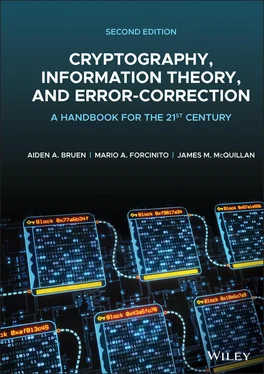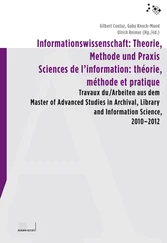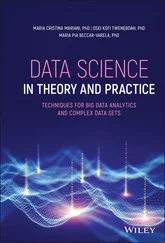Aiden A. Bruen - Cryptography, Information Theory, and Error-Correction
Здесь есть возможность читать онлайн «Aiden A. Bruen - Cryptography, Information Theory, and Error-Correction» — ознакомительный отрывок электронной книги совершенно бесплатно, а после прочтения отрывка купить полную версию. В некоторых случаях можно слушать аудио, скачать через торрент в формате fb2 и присутствует краткое содержание. Жанр: unrecognised, на английском языке. Описание произведения, (предисловие) а так же отзывы посетителей доступны на портале библиотеки ЛибКат.
- Название:Cryptography, Information Theory, and Error-Correction
- Автор:
- Жанр:
- Год:неизвестен
- ISBN:нет данных
- Рейтинг книги:5 / 5. Голосов: 1
-
Избранное:Добавить в избранное
- Отзывы:
-
Ваша оценка:
- 100
- 1
- 2
- 3
- 4
- 5
Cryptography, Information Theory, and Error-Correction: краткое содержание, описание и аннотация
Предлагаем к чтению аннотацию, описание, краткое содержание или предисловие (зависит от того, что написал сам автор книги «Cryptography, Information Theory, and Error-Correction»). Если вы не нашли необходимую информацию о книге — напишите в комментариях, мы постараемся отыскать её.
A rich examination of the technologies supporting secure digital information transfers from respected leaders in the field Cryptography, Information Theory, and Error-Correction: A Handbook for the 21ST Century
Cryptography, Information Theory, and Error-Correction
Cryptography, Information Theory, and Error-Correction — читать онлайн ознакомительный отрывок
Ниже представлен текст книги, разбитый по страницам. Система сохранения места последней прочитанной страницы, позволяет с удобством читать онлайн бесплатно книгу «Cryptography, Information Theory, and Error-Correction», без необходимости каждый раз заново искать на чём Вы остановились. Поставьте закладку, и сможете в любой момент перейти на страницу, на которой закончили чтение.
Интервал:
Закладка:
The other main cryptographic technique used is transposition(or permutation) in which the letters of the message are simply rearranged according to some prescribed formula which would be the secret key in that case.
The Greeks were the inventors of the first transpositioncipher. The Spartans [Kah67] in the fifth century BCE, were the first recorded users of cryptography for correspondence. They used a secret device called a scytale consisting of a tapered baton around which was spirally wrapped either a strip of parchment or leather on which the message was written. When unwrapped, the letters were scrambled, and only when the strip was wrapped around an identically sized rod could the message be read.
Today, even with the advent of high‐speed computers, substitutionand transpositionform the fundamental building blocks of ciphers used in symmetric cryptography.
To put it in a historical perspective, asymmetricor public keycryptography was not invented until the 1970s. Exactly when it was invented, or who should take most of the credit, is an issue still in dispute. Both the NSA 1 and the CESG 2 have claimed priority in the invention of public key cryptography.
Cryptography has had several reincarnations in almost all cultures. Because of the necessity of keeping certain messages secret (i.e. totally unknown to potential enemies) governments, armies, ecclesiastics, and economic powers of all kinds have been associated throughout history with the development of cryptography. This trend continues today.
The Roman General Julius Caesar was the first attested user of substitution ciphers for military purposes [Kah67, p. 83]. Caesar himself recounted this incident in his Gallic Wars . Caesar found out that Cicero's station was besieged and realized that without help, he would not be able to hold out for long. Caesar had a volunteer ride ahead, with an encrypted message fastened to a spear which he hurled into the entrenchment. Basically, Cicero was told to keep up his courage and that Caesar and his legions were on their way.
In the cipher form used by Caesar, the first letter of the alphabet “A” was replaced by the fourth letter “D,” the second letter “B” by the fifth “E,” and so on. In other words, each original letter was replaced by one three steps further along in the alphabet. To this day, any cipher alphabet that consists of a standard sequence like Caesar's is called a Caesar alphabet even if the shift is different from three.
Not much mention is made of the coding abilities of Augustus Caesar, the first Emperor of Rome and nephew of Julius Caesar. His cipher involved a shift of only one letter so that for the plain text (that is the original text) A was enciphered as B.
Mention of cryptography abounds in early literature: Homer's Iliad refers to secret writing. The Kama‐sutra , the famous text book of erotics from the Indian subcontinent, lists secret writing as one of the 64 arts or yogas that women should know and practice [Kah67, p. 75]. One of the earliest descriptions of the substitution technique of encryption is given therein. One form involves the replacement of vowels by consonants and vice versa.
In Hebrew literature, there are also examples of letter substitution. The most prevalent is the atbashtechnique. Here the first and last, second and second last, and so on, letters of the Hebrew alphabet are interchanged. An example can be found in the Old Testament of the Bible. Kahn [Kah67, p. 77] cites Jeremiah 25: 26 and Jeremiah 51: 41, where the form “SHESHACH appears in place of Babel (Babylon).”
In Jeremiah 51: 41, the phrase with SHESHACH is immediately followed by one using “Babylon.” To quote:
How is SHESHACH taken!
And the praise of the whole earth seized!
How is Babylon become an astonishment
Among the nations!
Through Aramaic paraphrases of the Bible, it is clear that SHESHACH is the same as Babel. With the atbash technique, the second letter of the Hebrew alphabet “b” or beth becomes the repeated SH or SHIN, the next to last letter in the alphabet. Similarly, the “l” of lamed , becomes the hard ch, or kaph of SHESHACH. Since Babylon appears below, the use of atbash here was not to actually hide the word but perhaps just a way for the scribe to leave a trace of himself in the work he was copying.
The first people to clearly understand the principles of cryptography and to elucidate the beginnings of cryptanalysis were the Arabs [Kah67]. While Europe was in the Dark Ages, Arab arts and science flourished and scholars studied methods of cryptanalysis, the art of unscrambling secret messages without knowledge of the secret key. A complete description of this work, however, was not published until the appearance of the multivolume Subh al‐a'sha by about 1412.
European cryptology was being developed around this time in the Papal States and the Italian city‐states [Kah67]. The first European manual on cryptography (c1379) was a compilation of ciphers by Gabriele de Lavinde of Parma, who served Pope Clement VII. The Office of Cipher Secretary to the Pope was created in 1555. The first incumbent was Triphon Bencio de Assisi. But considerably before this in 1474, Cicco Simonetta wrote a manuscript that was entirely devoted to cryptanalysis.
Cryptanalysis was to have tragic consequences for Mary, Queen of Scots. It was the decipherment of a secret message to Anthony Babington supposedly planning an insurrection against Elizabeth I [Lea96] that resulted in her tragic end. Having obtained this evidence, Sir Francis Walshingham, the head of Queen Elizabeth's secret service, sent his agent back to Fotheringay Castle, to intercept and copy more of Mary's secret messages with the result that Mary and all her coconspirators were finally arrested. As a result of the trial, all were executed but only Mary was beheaded. Walshingham later claimed that his agents had found the keys to as many as 50 different ciphers in Mary's apartments. (There has long been a conjecture that Mary was actually innocent and that the evidence was planted to remove this inconvenient rival to the English throne.)
The architect, Leon Battista Alberti born in Florence in 1404, is known as “the Father of Western Cryptology.” In 1470, he published Trattati in Cifra , in which he described the first cipher disk. His technique led to a generalization of the Caesar cipher, using several shifted alphabets instead of just one alphabet. This gave rise to the so‐called Vigenère cipher discussed in Chapter 2. (This is actually a misattribution as de Vigenère worked on auto‐key systems).
In 1563, the Neapolitan, Giovanni Battista Porta published his De Furtivis Literarum Notis on cryptography, in which he formalized the division of ciphers into transposition and substitution.
Moving up several centuries, we find that cryptography was widely used in the American Civil War. The Federal Army [Bri97] made extensive use of transposition ciphers in which a key word indicated the order in which columns of the array were to be read and in which the elements were either plain text words or codeword replacements for plain text. Because they could not decipher them, the Confederacy, sometimes in desperation, published Union ciphers in newspapers appealing for readers to help with the cryptanalysis. To make matters worse for the Confederate Army, the Vigenère cipher which they themselves used was easily read by the Union Army.
Kahn reports [Kah67, p. 221] that a Vigenère tableau was found in the room of John Wilkes Booth after President Lincoln was shot. Because there was actually no testimony regarding any use of the cipher, could this have been a convenient method of linking Booth and the seven Southern sympathizers with the Confederate cause?
Читать дальшеИнтервал:
Закладка:
Похожие книги на «Cryptography, Information Theory, and Error-Correction»
Представляем Вашему вниманию похожие книги на «Cryptography, Information Theory, and Error-Correction» списком для выбора. Мы отобрали схожую по названию и смыслу литературу в надежде предоставить читателям больше вариантов отыскать новые, интересные, ещё непрочитанные произведения.
Обсуждение, отзывы о книге «Cryptography, Information Theory, and Error-Correction» и просто собственные мнения читателей. Оставьте ваши комментарии, напишите, что Вы думаете о произведении, его смысле или главных героях. Укажите что конкретно понравилось, а что нет, и почему Вы так считаете.












